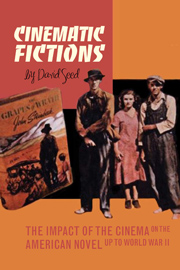Book contents
- Frontmatter
- Contents
- Introduction
- 1 Beginnings
- 2 Modernist Experiments: Gertrude Stein and Others
- 3 H.D. and the Limits of Vision
- 4 Ernest Hemingway: The Observer's Visual Field
- 5 Success and Stardom in F. Scott Fitzgerald
- 6 William Faulkner: Perspective Experiments
- 7 John Dos Passos and the Art of Montage
- 8 Dreiser, Eisenstein and Upton Sinclair
- 9 Documentary of the 1930s
- 10 John Steinbeck: Extensions of Documentary
- 11 Taking Possession of the Images: African American Writers and the Cinema
- 12 Into the Night Life: Henry Miller and Anaïs Nin
- 13 Nathanael West and the Hollywood Novel
- Bibliography
- Index
7 - John Dos Passos and the Art of Montage
- Frontmatter
- Contents
- Introduction
- 1 Beginnings
- 2 Modernist Experiments: Gertrude Stein and Others
- 3 H.D. and the Limits of Vision
- 4 Ernest Hemingway: The Observer's Visual Field
- 5 Success and Stardom in F. Scott Fitzgerald
- 6 William Faulkner: Perspective Experiments
- 7 John Dos Passos and the Art of Montage
- 8 Dreiser, Eisenstein and Upton Sinclair
- 9 Documentary of the 1930s
- 10 John Steinbeck: Extensions of Documentary
- 11 Taking Possession of the Images: African American Writers and the Cinema
- 12 Into the Night Life: Henry Miller and Anaïs Nin
- 13 Nathanael West and the Hollywood Novel
- Bibliography
- Index
Summary
We have seen instances in the previous chapter of William Faulkner using montage. We now need to turn to the leading theorist of montage – the Soviet film-maker Sergei Eisenstein – and to a novelist who from the beginning of his career saw film as helping his aim of social investigation: John Dos Passos. Although Eisenstein will figure in this chapter as a leading practitioner and theorist of montage, he himself admitted that this form of construction had been suggested to him by the methods of D. W. Griffith, the ‘most thrilling figure against this background’ as he called him. As many critics have noted, Griffith pioneered a method of cutting between sequences which became one of the hallmarks of modernist fiction and which Michael Rogin has summarized as follows:
by cutting back and forth, Griffith juxtaposed events separated in time (the flashback) and space (the cutback) and collapsed the distinctions between images in the head and events in the world. By speeding up, reversing, and stopping time, he brought the past into the present […] By juxtaposing events widely separated in space, he overcame the barriers of distance […] Griffith created an art of simultaneities and juxtapositions rather than traditions and continuities.
It is this fracturing of narrative sequence which we will encounter again and again in the present chapter and in subsequent chapters in which juxtaposition features prominently.
- Type
- Chapter
- Information
- Cinematic FictionsThe Impact of the Cinema on the American Novel up to World War II, pp. 128 - 150Publisher: Liverpool University PressPrint publication year: 2009
- 1
- Cited by



